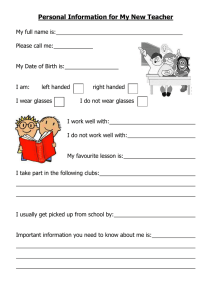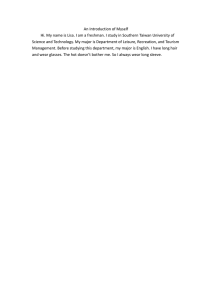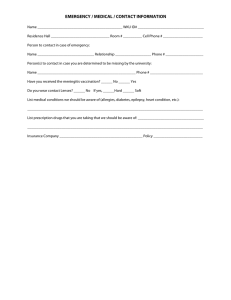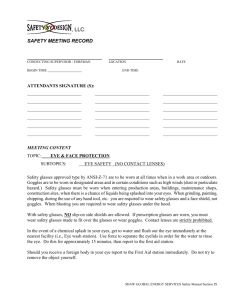Eye Protection at Work
advertisement
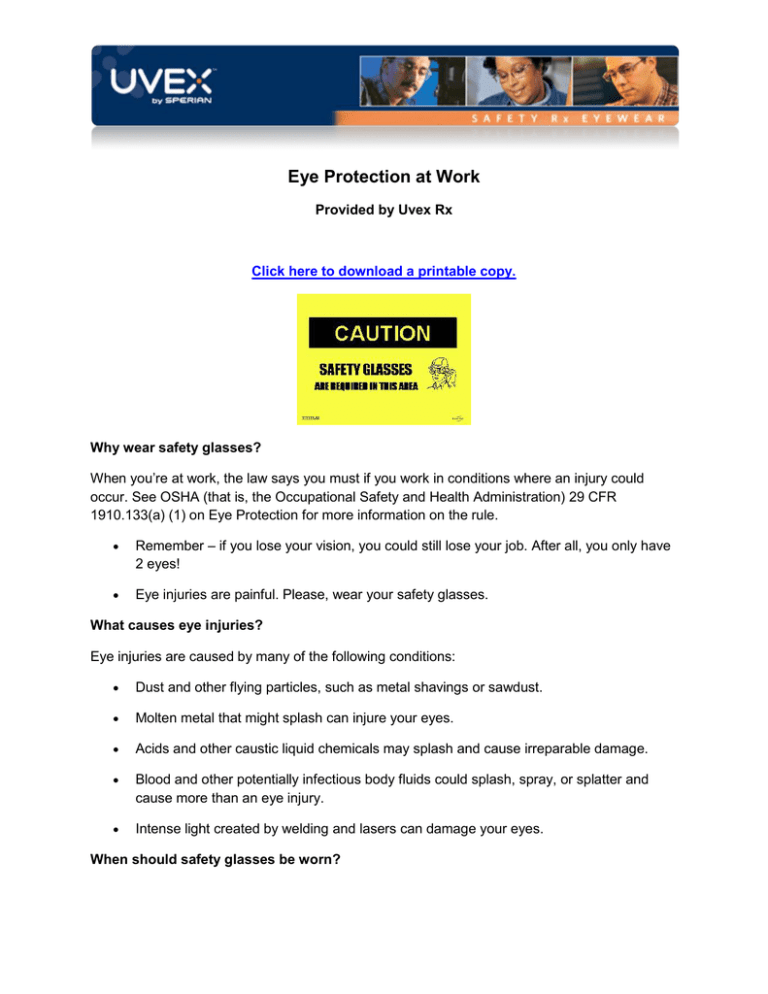
Eye Protection at Work Provided by Uvex Rx Click here to download a printable copy. Why wear safety glasses? When you’re at work, the law says you must if you work in conditions where an injury could occur. See OSHA (that is, the Occupational Safety and Health Administration) 29 CFR 1910.133(a) (1) on Eye Protection for more information on the rule. Remember – if you lose your vision, you could still lose your job. After all, you only have 2 eyes! Eye injuries are painful. Please, wear your safety glasses. What causes eye injuries? Eye injuries are caused by many of the following conditions: Dust and other flying particles, such as metal shavings or sawdust. Molten metal that might splash can injure your eyes. Acids and other caustic liquid chemicals may splash and cause irreparable damage. Blood and other potentially infectious body fluids could splash, spray, or splatter and cause more than an eye injury. Intense light created by welding and lasers can damage your eyes. When should safety glasses be worn? When chipping, grinding, sawing, drilling, sanding, welding, plating, handling chemicals, buffing, working in dusty conditions, brazing, casting, machining, riveting, or performing other similar tasks. And remember to always wear safety glasses when working near these operations. What kind of safety glasses should you wear? You should know your options – what kind should YOU wear? OSHA provides an Eye and Face Protection Selection Chart to help you decide. Look in Subpart 1, Appendix B, of the Non-mandatory Guidelines for Hazard Assessment. This can be found on their website – just go to www.osha.gov for more information. Here is an example of some of the selections available for eyewear protection. OSHA has definite guideline to use for selection of the appropriate product for your operation. What’s So Special About Prescription Safety Glasses? Prescription safety glasses are made specifically for the person who will be wearing them. Because of that they are usually more comfortable. o You can usually choose the style and color you like. o They incorporate your prescription in their design. o They protect your eyes against flying particles. o They can provide side protection when shields are attached. o Because you may unexpectedly be exposed to flying particles, side protection is STRONGLY recommended. o You’ll enjoy wearing today’s prescription safety glasses because they’re compliant yet lightweight and comfortable. What is Plano (non-Rx) Protective Eyewear? Non-prescription protective safety glasses are commonly called planos. Planos are good for people not needed prescription lenses. They are important for those wearing contact lenses, too. If you’ve had laser surgery, it is very important to protect your eyes on and off the job – planos are highly recommended. o Of course, you may be required to use over specs instead of prescription safety frames. When fitting them, be sure to pay close attention to the way they cover your dress glasses, and try to find a style that does not fall off when you bend your head down. The best and most comfortable protection, of course, would be prescription safety glasses. When Should I Wear Goggles? Goggles are a type of Plano. They protect your eyes, eye sockets, and the facial area immediately surrounding the eyes from impact, dust, and splashes. Some goggles fit over corrective lenses - corrective lenses include contacts and glasses. Be sure to study the OSHA guidelines before selecting your goggles. You may be required to wear goggles over your safety glasses. When Should I Wear a Face Shield? Face shields are made to protect your face from nuisance dusts and potential splashes or sprays from hazardous liquids. They DO NOT protect you from impact hazards. It is important to wear your protective eyewear under the face shield. You will note that OSHA specifies wearing protective eyewear under a face shield in their selection guide. When Should I Wear a Welding Shield? Welding Shields protect your eyes from burns caused by infrared or intense radiant light, and they protect your face and eyes from flying sparks, metal spatter, and slag chips produced during welding, brazing, soldering, and cutting. Please see 29CFR1910.133 (a) (5) for more information. Also see 29CFR1910 Subpart Q for regulations on Welding, Cutting & Brazing. When Should I Wear Laser Safety Glasses? Laser Safety Goggles protect your eyes from intense concentrations of light produced by lasers. OSHA 29CFR1926.102 (b) (2) (i) gives a chart specifying the proper protection needed. Important Information about Sideshields Here is some very important information about sideshield liability! Side shields are designed, manufactured, and they are tested to meet the ANSI Z87 standard for use on specifically designated safety frames. IF you use sideshields on frames that they are not designed for, they may fail or break upon impact. This is because they may have stress points due to a poor fit. Also, they may fall off if they are placed on the wrong frame – and that could cause you to suffer an eye injury! And please, NEVER put side shields on a dress frame – not only will they not fit correctly; but you could suffer a terrible eye injury because the frame and lenses do not meet the ANSI Z87 standards for impact protection. Keep in mind that OSHA references the ANSI standards in the regulations. ANSI stands for the American National Standards Institute. It sets the standards for product safety. ANSI Testing Requirements for Safety Glasses The following information explains the tests that the safety frame and lenses have to undergo to meet the ANSI standard and be able to be used to meet OSHA requirements. High Velocity Impact Test Here’s some interesting information about the High Velocity Impact Test. This test is performed by the manufacturer during the development of each new style. The frame is again tested regularly during the life of the frame’s sales cycle to ensure that it continues to be manufactured to the ANSI Z87 standard. Records are kept by the manufacturer. To perform the test, the frame, with non-prescription lenses, is mounted on a special head form. It is then shot with a ¼ inch steel ball traveling at about 150 feet per second – that’s a little over 100 miles per hour! No parts or fragments may be ejected. And no contact is permitted with the eye on the head form as a result of the impact. High Mass Impact Test Here’s some interesting information about the High Mass Impact Test. This test is performed by the manufacturer during the development of each new style. The frame is again tested regularly during the life of the frame’s sales cycle to ensure that it continues to be manufactured to the ANSI Z87 standard. Records are kept by the manufacturer. This test is convincing – the projectile that is dropped from a 51.2 inch tube weighs over one pound! Again, the frame and lenses must remain intact and no contact may be made with the head form. I wonder if many dress frames can pass this kind of testing. For Good Eye Protection - Make Sure You Wear Your Safety Glasses Correctly! Make sure you wear side shields! o Check to make sure your shields are positioned properly. o Push the shield forward so that the edge is over the front rim of your frame – never behind it! Keep them clean! Your safety frames will last longer and look better if you take good care of them. Following are just a few helpful hints: A good practice is to wash your frame and lenses when you wash your hands. Metal frames should last longer with daily cleaning – perspiration causes corrosion. Wash with dishwashing liquid and water or eyewear cleaner. Dry with soft high-quality tissue (without lanolin), lens wipes, or a soft cloth. Don’t “dry clean” your lenses- it scratches them (never use your shirt!). Inspect your glasses daily . Make it your practice to inspect your glasses daily – before you start your job. This isn’t just a “good idea” – it is part of the OSHA regulation. It is important that scratched or nicked lenses be replaced immediately. Scratched damaged lenses are weakened and can break upon impact. Think about the method used for cutting glass! The glass is scratched and then tapped -this causes the glass to break right along the scratched surface. The same applies to lenses. Also check your frame for broken parts – if you want your frame and lenses to protect you, they must be in good condition! Once in a while, you should also tighten your screws – when you tighten one, tighten them all. If you have a problem with screws backing out, just place a drop of glue or nail polish in the hole and then tighten your screw. That should solve your problem. If you mention the problem to your optician, he or she can do this for you. Wear your current prescription! Good vision is critical to your job performance AND your quality of life If you can’t see clearly, you could suffer an injury or even cause an injury! Protect your eyes on the job. . . and at home. This protective eyewear presentation is provided as a courtesy by Uvex Rx – a Sperian Protection company. Please feel free to contact us if you have any questions about your safety glasses. Have a Safe Day!

